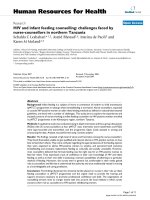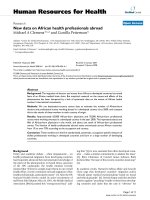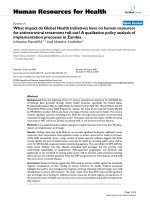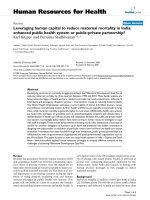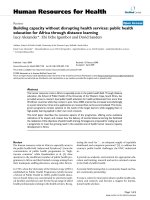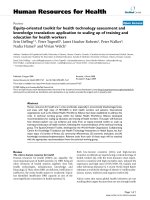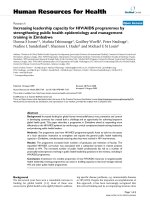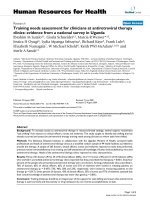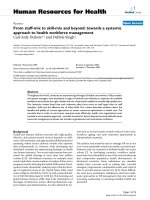báo cáo sinh học:" Meeting human resources for health staffing goals by 2018: a quantitative analysis of policy options in Zambia" potx
Bạn đang xem bản rút gọn của tài liệu. Xem và tải ngay bản đầy đủ của tài liệu tại đây (648.82 KB, 10 trang )
Tjoa et al. Human Resources for Health 2010, 8:15
/>Open Access
RESEARCH
© 2010 Tjoa et al; licensee BioMed Central Ltd. This is an Open Access article distributed under the terms of the Creative Commons At-
tribution License ( which permits unrestricted use, distribution, and reproduction in any
medium, provided the original work is properly cited.
Research
Meeting human resources for health staffing goals
by 2018: a quantitative analysis of policy options in
Zambia
Aaron Tjoa*
1
, Margaret Kapihya
2
, Miriam Libetwa
2
, Kate Schroder
1
, Callie Scott
4
, Joanne Lee
3
and Elizabeth McCarthy
1
Abstract
Background: The Ministry of Health (MOH) in Zambia is currently operating with fewer than half of the health workers
required to deliver basic health services. The MOH has developed a human resources for health (HRH) strategic plan to
address the crisis through improved training, hiring, and retention. However, the projected success of each strategy or
combination of strategies is unclear.
Methods: We developed a model to forecast the size of the public sector health workforce in Zambia over the next ten
years to identify a combination of interventions that would expand the workforce to meet staffing targets. The key
forecasting variables are training enrolment, graduation rates, public sector entry rates for graduates, and attrition of
workforce staff. We model, using Excel (Office, Microsoft; 2007), the effects of changes in these variables on the
projected number of doctors, clinical officers, nurses and midwives in the public sector workforce in 2018.
Results: With no changes to current training, hiring, and attrition conditions, the total number of doctors, clinical
officers, nurses, and midwives will increase from 44% to 59% of the minimum necessary staff by 2018. No combination
of changes in staff retention, graduation rates, and public sector entry rates of graduates by 2010, without including
training expansion, is sufficient to meet staffing targets by 2018 for any cadre except midwives. Training enrolment
needs to increase by a factor of between three and thirteen for doctors, three and four for clinical officers, two and
three for nurses, and one and two for midwives by 2010 to reach staffing targets by 2018. Necessary enrolment
increases can be held to a minimum if the rates of retention, graduation, and public sector entry increase to 100% by
2010, but will need to increase if these rates remain at 2008 levels.
Conclusions: Meeting the minimum need for health workers in Zambia this decade will require an increase in health
training school enrolment. Supplemental interventions targeting attrition, graduation and public sector entry rates can
help close the gap. HRH modelling can help MOH policy makers determine the relative priority and level of investment
needed to expand Zambia's workforce to target staffing levels.
Background
The human resources for health (HRH) shortage is esti-
mated at more than 4 million workers globally [1]. The
shortage of health workers is particularly acute in
resource-limited settings where it limits the provision of
even basic health services like antenatal care and infant
immunizations, and it prevents progress towards the
health-related Millennium Development Goals (MDG) of
improved maternal and child health and universal access
to HIV/AIDS treatment [1-4].
Several factors contribute to this shortage of health
workers. In some countries, underinvestment in training
institutions has led to an inadequate supply of profes-
sional health graduates [5-7]. Meanwhile, many qualified
health professionals migrate abroad to fill more lucrative
health positions [7-11]. Others join the private health
sector or leave the health sector altogether [3,12,13].
Policies to reduce HRH shortages include expanding
training institutions and providing incentives to improve
retention [14,15]. Such policies are being written into
* Correspondence:
1
Clinton Health Access Initiative, Boston, USA
Full list of author information is available at the end of the article
Tjoa et al. Human Resources for Health 2010, 8:15
/>Page 2 of 10
national multi-year, ministry-level HRH strategic plans
[16]. However, deciding among them or determining the
most appropriate level of investments in them presents a
significant challenge for decision-makers, as there is
uncertainty around predicting the effects of interventions
over time or the interplay between them [17].
HRH Shortage in Zambia
The Republic of Zambia is among the countries currently
facing an acute HRH shortage. According to the Govern-
ment of the Republic of Zambia Ministry of Health
(MOH), the country is operating with fewer than half the
health workforce necessary to deliver basic health ser-
vices, with even higher vacancy rates in rural areas [18].
Staff-to-population ratios nationally are as low as 1 doc-
tor per 14 500 people and 1 nurse per 1800 people
[19,20]; this is much lower than the 1 health worker per
400 people recommended by the Joint Learning Initiative
as the minimum threshold necessary to provide equitable
coverage of basic health services [1]. This shortage of
health workers is threatening adequate and equitable
health care delivery, and it is one of the major factors
holding back attainment of the Millennium Development
Goals [21].
In 2005, the MOH initiated a policy reform process to
address this critical shortage in the public sector [21].
The Zambian MOH established employment targets for
each health worker cadre based on recommended World
Health Organization (WHO) staff-to-population ratios
(2.3 to 1000) with modifications by the MOH and health
facility managers [7]. The Zambian Human Resources for
Health Strategic Plan 2006 to 2010 established targets
and strategies to achieve them through improvements in
HRH management, training, and retention [21]. However,
to establish the best combination of strategies, a model-
ling exercise was required. Our objective was to provide
practical guidance on this question by estimating the
training, hiring, and retention combinations that would
enable the MOH to reach its targets in the next ten years.
Other modelling efforts have been developed to estab-
lish optimal HRH staffing levels for planning purposes.
As reviewed elsewhere, models are often needs-based,
utilization-based, service-target based, adjusted-service-
to-target, or health workforce-to-population-based esti-
mates [22]. Models are useful planning tools and allow
decision-makers to anticipate the impact of certain deci-
sions under different scenarios. For example, scaling up
HIV services in Mozambique and the associated health
worker requirements were modelled to assist workforce
planning [23]. Here we present single variable and multi-
ple variable scenario analyses of the supply of health
workers in a model that uses health workforce to popula-
tion ratios to understand minimum staffing requirements
in Zambia.
Methods
Study design
We built an HRH projection model to estimate the size of
the government health workforce in 2018. We focused
our analysis on four key cadres: doctors, clinical officers,
nurses, and midwives. These cadres account for 80% of
current clinical staff and 75% of employment targets. We
forecasted HRH supply under current conditions and
then estimated the effect on the size of the government
health workforce by modelling changes in training enrol-
ment, graduation rates, public sector entry rates of gradu-
ates, and attrition rates.
HRH projection model
Our HRH projection model uses Excel (Microsoft Office,
Microsoft; 2007) to forecast the annual number of health
workers in the public sector workforce for each cadre
based on the annual inflows and outflows of each cadre in
the public sector health workforce. The annual number of
staff leaving the workforce includes the number of health
workers going back to school as well as those lost to attri-
tion. Annual attrition is calculated by measuring the size
of each cadre before new hires multiplied by the work-
force attrition rates for each cadre. The annual inflow of
staff is equal to the sum of new hires from training insti-
tutions and from abroad. To calculate the number of hires
from training institutions in a year, the model multiplies
together the number of training institution students in
their final year of study from the prior year, the gradua-
tion rate for the prior year, and the rate that graduates
entered the public sector workforce in the previous year:
To avoid overproduction of health workers, the model
does not allow the number of health workers in the public
sector to exceed the target number for each cadre. If a
cadre is expected to reach its target level, the model
reduces the number of training enrolment slots in
advance of that point so the workforce will meet but not
exceed the target number.
The model allows the user to establish attrition rates,
immigration inflow, training enrolment, graduation rates,
and public sector entry rates for each year. We assume
that training institution enrolment slots can always be
filled with qualified students.
Model parameters
Workforce parameters
Baseline estimates for key staff (doctors, clinical officers,
nurses, and midwives) come from Ministry of Health
payroll data from September 2008 (Table 1) [24,25]. The
ProjectedWorkforce ProjectedWorkforce ProjectedWorkf
tt
=
−
1
– oorce AttritionRate
StaffReturningToSchool Stud
tt
t
−
()
+
1
*–
(
eentsInFinalYearOfStudy
GraduationRate ofGraduates
t
t
−
−
1
1
*
*% HHiredIntoPublicSector
ImmigrantHires with t forec
t
t
−
+=
1
)
, aast year
Tjoa et al. Human Resources for Health 2010, 8:15
/>Page 3 of 10
Table 1: Baseline inputs
Nurses Midwives
Baseline inputs Doctors Clinical
officers
registered enrolled registered enrolled direct entry Total
Number of staff
At baseline (2008)
1
806 1236 1453 5134 339 1711 0 10 679
Minimum level required to meet
need (same for all years)
2
1778 3737 14 053 4751 24 319
Inflow from training
Annual training enrolment (# of new
students)
3
74 155 660 423 136 173 174 1795
Total years of training required
3
73 3 2 1 1 2 n/a
Graduation rate (% of students)
3
90.0% 90.0% 96.7% 94.3% 97.1% 90.7% 90.0% n/a
Public sector entry rate from training
schools (% of graduates)
3,4
85.3% 91.4% 75.5% 81.4% 81.4% 81.4% 81.4% n/a
Inflow from immigration (# per year)
4
20 0 0 0 0 0 0 20
Outflow from attrition
Training program requires other
professional diploma/degree and
work experience before enrolling; or
enrols students who leave the public
sector workforce before enrolling
No No Yes No Yes Yes no n/a
If yes, which specific cadre is the
feeder cadre for training programs
n/a n/a enrolled
nurses
n/a registered
nurses
enrolled
nurses
n/a n/a
Percent of enrolling students to
which entry barrier applies (% per
year)
n/a n/a 14.89% n/a 100% 100% n/a n/a
Total attrition from cadre (% per
year)
9.80% 4.48% 5.30% 4.48% 4.48% 4.48% 4.48% n/a
Involuntary attrition (% per year)
[24,26]
6.66% 3.05% 3.60% 3.05% 3.05% 3.05% 3.05% n/a
Voluntary attrition (% per year) [25,26] 3.14% 1.43% 1.70% 1.43% 1.43% 1.43% 1.43% n/a
1
MOH human resources payroll data, September 2008
2
MOH Training and Development Plan 2008
3
MOH/CHAI training institution assessment, May/June 2008
4
MOH Human Resources Directorate
Tjoa et al. Human Resources for Health 2010, 8:15
/>Page 4 of 10
model categorizes attrition as voluntary or involuntary.
Voluntary attrition occurs when a health worker who is
still able to perform her duties in the public sector work-
force chooses to exit the workforce permanently such as
leaving the health sector. Involuntary attrition occurs
when a health worker leaves permanently due to a condi-
tion that would prevent her from continuing to work in
the public sector workforce (e.g. serious illness, dismissal,
death, or retirement). We assume 68% of total attrition is
involuntary and 32% is voluntary based on a Ministry of
Health survey [26]. The components of involuntary attri-
tion in the survey include dismissal (12%), retirement
(10%), contract expiration or transfer (8%), and serious
illness and death (38%) with AIDS being the leading
cause of death. Voluntary resignation (32%) is the only
component of voluntary attrition [26].
Training parameters
Training parameter estimates were derived from a 2008
joint Ministry of Health and Clinton Foundation assess-
ment of all 39 medical training institutions in Zambia.
The assessment determined graduation rates to be 90-
97%, based on available data and interviews with school
staff [27].
The same assessment determined that enrolled and
registered midwifery training programs require all their
students to have nursing professional health diplomas
and prior work experience. Additionally, it found 15% of
students in the registered nursing program to be former
enrolled nurses who left the workforce for further school-
ing. We use this information to determine the number of
nurses who leave the workforce annually to go back to
school.
Hiring parameters
For simplicity, we assumed graduates are hired into the
public sector and begin working within one calendar year
after their graduation year for all cadres. To estimate the
proportion of new graduates who enter the public sector,
we divided the aggregate number of new hires during the
period of January 2007 to February 2008 by the number
of graduates from training institutions during the same
time period [28]. In Zambia, all new non-doctor hires
come from Zambian training institutions, and all new
doctor hires come from either Zambian training institu-
tions or other countries in the region, with 20 new doc-
tors hired from abroad annually [28].
What-if analyses
We conducted what-if analyses to estimate the effects of
changes in training, hiring, and attrition conditions on
the supply of HRH over time. We assumed all changes
would take effect by 2010.
Results
Base case analysis
Under current conditions, the number of doctors, clinical
officers, nurses, and midwives in the public sector is
expected to increase from 10 679 in 2008 to 14 402 in
2018, or from 44% to 59% of minimum necessary staff
far short of the 24 319 recommended by the government
(Table 2). The increase in these key healthcare workers
from 2008 to 2018 is expected to be a result of an influx of
14 030 new hires that enter into the public sector and a
loss of 10 307 existing staff who exit. The sources of the
new hires are 13 830 graduates from training institutions
and 200 doctors from abroad.
Notably, 4121 students are not expected to enter the
public workforce either because of their failure to gradu-
ate (1067) or because they graduate but will seek employ-
ment elsewhere (3054) (Table 2). Of the 10 307 key health
workers who leave the workforce during the 10 year
period, 4073 (40%) leave to go back to school, 4239 (41%)
leave for involuntary reasons, and 1995 (19%) leave for
voluntary reasons.
By cadre, the number of doctors is expected to decrease
by 14 with no changes in current trends, while the num-
ber of clinical officers, nurses, and midwives are expected
to increase by 592, 921, and 2224 respectively over the ten
year period. Shortfalls from the minimum requirement
remain significant by 2018 without changes in current
trends (986 for doctors, 1909 for clinical officers, 6545 for
nurses and 477 for midwives).
Single variable what-if analyses
We projected the number of key healthcare workers in
the public sector under several single-variable (one-at-a-
time) intervention scenarios that would take effect by
2010. These included increasing the graduation rate to
100%, increasing the public workforce entry rate to 100%,
decreasing voluntary attrition to 0%, doubling training
enrolment, and tripling training enrolment (Table 3). By
itself, with no changes in attrition and hiring rates from
current trends, increasing training enrolment had the
largest impact on the size of the total workforce by 2018.
However, each type of intervention has a different
effect on each cadre. For example, decreasing voluntary
attrition to 0% has the same impact by 2018 on the num-
ber of doctors who have the highest annual voluntary
attrition rate at 3.14% as tripling training enrolment.
Increases in training enrolment have the largest effects
for clinical officers, nurses, and midwives who each
require only up to three years to train, compared to doc-
tors who require 7 years to train in Zambia.
Under the single-variable intervention scenarios,
increases in training enrolment were the only interven-
tions with enough potential power to reach public sector
staffing targets by 2018. To reach the combined cadre tar-
get of 24 319 staff by 2018, training enrolment must grow
by a factor of thirteen for medical doctors (from 74 to 960
per year), quadruple for clinical officers (from 155 to 623
per year), triple for nurses (from 1083 to 2924 per year),
and grow by a quarter for midwives by 2010 (from 483 to
Tjoa et al. Human Resources for Health 2010, 8:15
/>Page 5 of 10
589 per year). However, in the scenario of only increasing
training enrolment, the Government of Zambia could
significantly reduce training enrolment from these higher
new enrolment levels after it reaches its staffing targets.
Once a scale-up of the workforce to staffing targets is
completed by 2018 under the training enrolment sce-
nario, the number of new hires only has to equal the
number of new exits from the workforce. The equilib-
rium level of training enrolment necessary to sustain the
workforce at the target level once it has been reached is
201 for medical doctors (172% increase over baseline),
204 for clinical officers (32% increase over baseline), 275
for nurses (18% increase over baseline), and 285 for mid-
wives (41% decrease of baseline), assuming no changes to
the current hiring and attrition rates.
Multi-variable what-if analyses
We conducted a four-way what-if analysis to determine
which combinations of changes in training enrolment,
the graduation rate, the public sector entry rate, and attri-
tion would enable the MOH to reach its staffing targets
by 2018. The analysis determined that staffing targets
could be reached by 2018 for each rate of attrition, gradu-
ation, and public sector entry rate achieved by 2010, as
long as there is a large enough accompanying increase in
training enrolment by 2010 (figure 1).
Doctor targets could be reached by 2018 with smaller
increases in training enrolment by reducing attrition and
increasing the graduation and public sector entry rate of
doctors by 2010. Without changes in current levels of
attrition, graduation and public sector entry rates, train-
ing enrolment of doctors would have to be increased by a
factor of thirteen (13×). However, if attrition is reduced to
0% and graduation and public sector entry is increased to
100% by 2010, the increase in training enrolment
required falls to a factor of three (3×) for doctors. As a
mid-range scenario, decreasing attrition by five percent-
age points for doctors could change the necessary train-
ing enrolment increase from thirteen times to ten times
current levels. Alternatively, the same benefits could be
achieved by increasing the combined graduation and
public sector entry rate by twenty percentage points.
Reducing attrition and increasing graduation and pub-
lic sector entry rate by 2010 for clinical officers, nurses,
and midwives does not have as significant an effect on the
required increase in the size of the training enrolment
increase as it does for doctors. At current levels of attri-
tion, training enrolment must be increased by a factor of
four (4×) for clinical officers, three (3×) for nurses, and
two (2×) for midwives by 2010 in order to reach targets by
2018. If attrition is reduced to 0% and graduation and
public sector entry is increased to 100% by 2010, the
increase in training enrolment required only falls to a fac-
tor of three (3×) for clinical officers, two (2×) for nurses,
and one (1×) for midwives. In the case of midwives, how-
ever, reducing attrition by two percentage points or
increasing graduation and public sector entry by fifteen
percentage points from current levels by 2010 will enable
the MOH to meet midwives staffing targets by 2018 with-
out an increase in training enrolment (1×).
If attrition rates were to increase or the graduation and
public sector entry rate were to fall over time, it would
make reaching doctor targets by 2018 even more difficult.
For every increase in the attrition rate by two percentage
points or for every drop in the graduation and public sec-
tor entry rate by ten percentage points, current doctor
training enrolment would have to increase by an addi-
tional one hundred to two hundred percentage points to
reach staffing targets by 2018. The level by which clinical
officer and nurse training enrolment must increase to
reach staffing goals by 2018 is also sensitive to increases
in the attrition rate or decreases in the graduation and
public sector entry rate, but much less so than it is for
doctors. Roughly, for every increase in the attrition rate
by four percentage points or for every decrease in the
graduation and public sector entry rate by fifteen per-
centage points, there would have to be a one hundred
percentage point increase in training enrolment to reach
staffing targets by 2018 for both clinical officers and
nurses. Increases in attrition or decreases in the gradua-
tion and public sector entry rate do not significantly
affect the training enrolment needs for midwives to reach
staffing goals by 2018.
Discussion
We projected the supply of HRH in the public sector in
Zambia from 2008 to 2018 under a number of scenarios.
Zambia will not reach target levels for health workers in
the next ten years at current levels of training institution
enrolment, attrition, and graduation and public sector
entry rates, thereby threatening the country's ability to
provide adequate and equitable health care delivery to
meet its MDGs.
Our analysis identified several optimal combinations of
changes in training institution enrolment, attrition, grad-
uation rates, and public sector entry rates to enable Zam-
bia to employ its required number of health workers for
the public sector by 2018. In any scenario, a significant
increase in training institution enrolment is critical for all
cadres but midwives; doubling, tripling or even expand-
ing by up to 13 times the current levels of training enrol-
ment is required for doctors, clinical officers, and nurses.
Doctors require the largest increase in training enrol-
ment to meet minimum staffing needs within the decade
because they have the longest training time. Clinical offi-
cers and nurses require significant but much smaller
increases in training enrolment (by a factor of four and
three respectively). Targets for midwives can be met with
Tjoa et al. Human Resources for Health 2010, 8:15
/>Page 6 of 10
Table 2: Projected changes in Zambian HRH workforce from 2008 to 2018 under current conditions of production and
attrition
Doctors Clinical officers Nurses Midwives Total
Projected HRH workforce in 2018 ( = baseline + inflow - outflow) 792 1828 7508 4274 14 402
Baseline HRH workforce 806 1236 6587 2050 10 679
Inflow from 2008 to 2018 ( = a - b - c + d) + 768 + 1275 + 8359 + 3628 + 14 030
a Students that enrolled + 740 + 1550 + 10 831 + 4830 + 17 951
b Students that failed to graduate - 74 - 155 - 463 - 375 - 1067
c Graduates not hired into public sector - 98 - 120 - 2009 - 827 - 3054
d Hired from abroad + 200 + 0 + 0 + 0 + 200
Outflow from 2008 to 2018 ( = e + f + g + h) - 782 - 683 - 7438 - 1404 - 10 307
e Retire - 78 - 68 - 337 - 140 - 623
f Involuntary attrition - 454 - 396 - 1951 - 815 - 3616
g Voluntary attrition - 250 - 219 - 1077 - 449 - 1995
h Go back to school - 0 - 0 - 4073 - 0 - 4073
Total gain or loss between 2008 to 2018 - 14 + 592 + 921 + 2224 + 3723
Remaining staffing gap in 2018 986 1909 6545 477 9917
This table contains outputs from the HRH projection model.
either an increase in training enrolment or an interven-
tion that improves retention, graduation, and public sec-
tor entry rates. Interventions that improve retention,
graduation, and public sector entry rates are not suffi-
cient on their own to reach staffing targets by 2018 for
doctors, clinical officers, or nurses, but they can reduce
the size of the required increase in training enrolment,
especially for doctors.
Increasing training enrolment is the most expensive
option. It takes several years for training enrolment
changes to have an impact on the public workforce. This
delay is equal to the length of the training and hiring
pipeline for each cadre- the time that it takes for students
to be trained, graduate, and enter the workforce. By
cadre, the pipeline is eight years for medical doctors, four
years for clinical officers, three years for enrolled nurses,
four years for registered nurses, two years for registered
midwives, two years for enrolled midwives, and three
years for direct entry midwives. To increase the work-
force in the near future, training enrolment would need
to increase immediately. Nonetheless, policies to increase
training levels will not address immediate staffing needs,
particularly for cadres with the longest pipelines (medical
doctors and clinical officers).
Policy options could address the duration of the pipe-
lines. Fast-tracked training programs could produce staff
more quickly, or new cadres could be created that require
less time to train. Decreasing the amount of time that it
takes for the MOH to recruit and hire graduates could
also reduce the overall pipeline by up to a year.
Our model also identified another opportunity to
reduce immediate shortages by reducing the number of
nurses who leave the workforce to go back to school to
get advanced training. Removing prerequisites to
advanced nursing degrees (by allowing direct entry)
would reduce back-to-school attrition. Zambia has intro-
Tjoa et al. Human Resources for Health 2010, 8:15
/>Page 7 of 10
duced two such programs already: the direct-entry mid-
wifery diploma and the direct-entry nursing bachelor's
degree. The direct-entry midwifery diploma does not
require students to have a nursing diploma, and it only
requires two years of training compared to one year of
training for the registered and enrolled midwifery diplo-
mas. The non-direct entry nursing bachelor's degree
requires students to have a nursing diploma (minimum
two years training) and two years of nursing experience
prior to enrolment, but the direct-entry program requires
neither. The direct-entry degree only requires three years
of training compared to two years of training for a non-
direct entry nursing bachelors.
Nurses who leave the workforce to earn higher degrees
will not all re-enter the public sector workforce after
graduating, as they may choose more lucrative jobs in the
private sector or abroad where demand for health work-
ers is high. The estimated rate of retaining the nurses who
leave the public sector to go back to school is equal to the
graduation rate multiplied by public sector entry rate of
each program, currently around 73-79%.
The sizes of the training scale-up necessary to reach
staffing targets for doctors, clinical officers, and nurses by
2018 are likely unfeasible or prohibitively costly. There-
fore, even with significant gains in improving training
enrolment, retention, graduation, and public sector entry,
Zambia is likely to operate with a shortage of manpower
for at least the next decade unless alternative means of
addressing this shortage are determined. For example,
shifting some clinical tasks from doctors or clinical offi-
cers to nurses and midwives could leverage the ability of
nurses and midwives to care for significantly more
patients in the short run. Clerical and simple clinical
work (e.g. measuring a patient's height, weight, and vitals)
could potentially be performed by lay health workers.
Nurse- and clinical officer-centred care have resulted in
good clinical outcomes in Zambia, where these two cad-
res provided the bulk of paediatric HIV care in a number
of primary health care clinics in Lusaka [29]. Similar
results have been found elsewhere, for example in
Rwanda where nurses have provided paediatric antiretro-
viral therapy and in Kenya with family planning services
[30,31]. Rationally redistributing tasks among health
worker teams (task-shifting), according to a recent
review, can maintain quality while increasing efficiency
and improving access and affordability [32]. In a pilot in
Rwanda, the demand for physician time in providing HIV
care and treatment was reduce by 76% by expanding the
role of nurses in HIV services [33]. If Zambia were able to
replicate these results, the expansion of doctor training
enrolment, while still necessary, would not have to be as
extreme.
If Zambia increases training enrolment significantly, it
is unclear what Zambia would do with a large excess of
training graduates once current staffing needs are met.
The Philippines has experienced significant economic
benefits from the remittances of nurses who emigrate to
developed countries, though such a policy would have to
be carried out carefully in Zambia so as to avoid the can-
nibalization of staff hires and the potential for increased
outflows from the domestic public sector health work-
force due to emigration [34]. Anticipating this issue will
need to be part of the overall planning process for train-
ing enrolment scale-up.
While improvements in attrition over time do not have
the same benefits on the long-term health workforce as
improvements in training enrolment, reductions in attri-
tion will reduce the magnitude of needed training enrol-
ment increases that are required to meet targets and,
conversely, any increases in attrition over time will
Table 3: Projected impact of single interventions on the HRH workforce from 2008 to 2018
Single intervention scenario Number of health workers in 2018 (% of target level)
Combined Doctors Clinical officers Nurses Midwives
Baseline projection (no changes) 14 402 (59.2%) 792 (44.5%) 1828 (48.9%) 7508 (53.4%) 4274 (90.0%)
Increase graduation rate to 100% by 2010 15 049 (61.9%) 826 (46.5%) 1920 (51.4%) 7831 (55.7%) 4472 (94.1%)
Decrease voluntary attrition to 0% by 2010 16 199 (66.6%) 958 (53. 9%) 2000 (53.5%) 8713 (62.0%) 4528 (95.3%)
Increase public workforce entry rate to 100% by 2010 16 619 (68.3%) 846 (47.6%) 1906 (51.0%) 9144 (65.1%) 4723 (99.4%)
Double health training institution enrolment by 2010 19 108 (78.6%) 874 (49.2%) 2462 (65.9%) 11 021 (78.4%) 4751 (100%)
Triple health training institution enrolment by 2010 22 669 (93.2%) 957 (53.8%) 3095 (82.8%) 13 866 (98.7%) 4751 (100%)
Tjoa et al. Human Resources for Health 2010, 8:15
/>Page 8 of 10
Figure 1 Minimum changes in training enrolment, attrition, graduation, and public sector entry by 2010 that will achieve staffing targets
for each cadre by 2018. *the increase in training enrolment is described as a multiplier of current training enrolment, i.e. 1× implies no change in
enrolment, 2× implies a doubling of enrolment or 100% increase in enrolment, etc; please note that these multipliers were rounded up to the nearest
integer.
1
This assumes that the number of midwives trained each year remains at 2008 levels through 2018.
2
This axis is the graduation rate multiplied
by the public sector entry rate. This figure highlights the factor by which current training enrolment must increase by 2010 in order to reach staffing
targets by 2018, for each change in attrition, graduation, and public sector entry that is achieved by 2010. The x-axis represents the percent enrolment
into the public sector from training institutions (graduation rate multiplied by the public sector entry rate) and the y-axis represents percent attrition.
A 1× means that training enrolment remains at current levels, while a 2× signifies the need for a doubling of current training enrolment, and so on. A
bold box indicates the current rate of attrition, graduation, and public sector entry and the corresponding necessary increase in training enrolment if
these other variables remained constant. For example, if 80% of graduating doctors entered the public sector, and attrition were 10% (both of which
are close to current rates), then training enrolment would need to increase 13-fold in order to produce enough doctors to meet the targets set for
2018. If there were an increase in graduation and public sector entry and a reduction in attrition, the factor by which training enrolment would need
to increase could be brought down as low as three.
Tjoa et al. Human Resources for Health 2010, 8:15
/>Page 9 of 10
enlarge the magnitude of needed training enrolment
increases that are required to meet targets. Two new gov-
ernment policies have the potential to reduce attrition.
Zambia currently requires students in government-sup-
ported training institutions to work in the public sector
workforce for a specified number of years after gradua-
tion under a bond. Efforts to enforce or even expand the
time requirement of this policy should reduce attrition of
newly hired health workers. Furthermore, the MOH is
piloting retention schemes that provide monetary and
working environment incentives to keep staff in the pub-
lic sector, especially in rural areas [25]. Improving work-
ing conditions is a strategy that is likely to improve
retention, as health staff who are operating under desir-
able working conditions and well equipped to do their job
are more likely to have higher job satisfaction and remain
in the public sector health system [35]. If successful and
scaled up, these programs could provide strong comple-
ments to training enrolment increases, especially for doc-
tors who have the highest attrition rates.
Study limitations
This study has several limitations. Our intent in this anal-
ysis was to suggest training, hiring, and attrition condi-
tions under which the MOH can reach its HRH target in
the next ten years. Our conclusions should be interpreted
with caution since we do not analyze the feasibility and
costs that are associated with each intervention. A study
was commissioned by the MOH subsequent to this analy-
sis that examined the feasibility and costs of doubling
training institution enrolment for all cadres by 2012 [27].
The findings of that cost study along with the results of
our HRH strategy analysis allowed the MOH to under-
stand the costs and benefits of investing in training insti-
tution enrolment, ultimately leading to the MOH's
decision to increase training enrolment. More studies will
be necessary to determine the feasibility and costs of
improving hiring and retention conditions across all cad-
res in Zambia, with the ultimate goal of combining that
costing information with this strategy analysis to under-
stand the relative costs and benefits of all HRH policies.
This analysis assumes an unlimited demand for slots in
training institutions. While anecdotal evidence suggests
that there is currently a surplus of qualified applicants at
the national training institutions, this may change if
training institution enrolment were increased dramati-
cally. Adequate preparation in primary and secondary
education becomes even more crucial in the preparation
of a good supply of eligible and qualified applicants. We
also assume the MOH has an unlimited capacity to
absorb newly-trained health workers. It is possible that
the government will not be able to hire graduates of train-
ing institutions at current rates if the number of gradu-
ates grows. Historically, international monetary
institutions have imposed limitations on the expansion of
the public sector workforce in debtor countries [36].
Unforeseen changes to the labour market also have the
potential to alter the government's ability to hire and
retain graduates. Moreover, we caution that these esti-
mates of workforce need are made at the national level,
while staffing levels at the local level will vary, affecting
access.
Our findings are based on a wide range of possible val-
ues for training institution enrolment, attrition, gradua-
tion rates, and public sector entry rates. Our projections
assume the structure of the workforce will remain the
same over time and does not incorporate potential
changes in productivity such as those from task shifting
and skill mix. We make a number of assumptions for the
model parameters based on the best available data. As the
population of Zambia continues to grow, it is likely that
staffing targets will also increase given their rooting in
population size; however, we do not update the staffing
targets in our analysis to reflect this estimated growth but
rather use the current MOH approved established targets
for the health cadres. Furthermore, our analysis focused
on a ten year horizon. If this time horizon is lengthened
or shortened, our results would change.
Finally, our analysis suggests a rapid increase in the
training enrolment in the next ten years, which could be
followed by a large decrease after targets are reached.
This would need to be taken into consideration down the
road so as to avoid an equally rapid increase in attrition
from the workforce as this large group of trainees that
graduate in the next ten years retires or leaves the work-
force.
Conclusions
Closing the gap between the demand and supply of health
workers in Zambia requires an increase in health training
school enrolment. Supplemental interventions targeting
attrition, graduation and public sector entry rates can
help close the gap. HRH modelling provides a valuable
tool to help policy makers examine how a range of policy
options would impact the supply of HRH.
Following this analysis, the Government of Zambia
called for an increase in current training enrolment by
over 90% across all cadres. In May and June of 2008, the
Government of Zambia and the Clinton Foundation
assessed all 39 of Zambia's health training institutions to
develop a full-cost estimate of the needs associated with
meeting these expanded targets [27]. The Government is
currently scaling-up enrolment through investments in
infrastructure and faculty over the next five years.
Abbreviations
AIDS: Acquired immune deficiency syndrome; CHAI: Clinton HIV/AIDS Initiative;
HIV: Human immunodeficiency virus; HR: Human Resources; HRH: Human
Tjoa et al. Human Resources for Health 2010, 8:15
/>Page 10 of 10
resources for health; MDG: Millennium Development Goal; MOH: Ministry of
Health; WHO: World Health Organization;
Competing interests
The authors declare that they have no competing interests.
Authors' contributions
MK and KS conceived of the study, guided the analysis, and coordinated the
collection of data. AT helped to develop the model, assisted in the collection of
data, assisted in the sensitivity and what-if analyses, and helped to draft the
manuscript. CS performed the sensitivity analysis and helped to draft the man-
uscript. EM helped to conceive the design of the study, coordinated the analy-
sis, and helped to draft the manuscript. JL and ML performed the analysis of
the training institutions and assisted with the collection of data. All authors
contributed to the writing of and approve the content in the final manuscript.
Acknowledgements
The authors wish to acknowledge the support of Jere Mwila and Charmaine
Pattinson, and the technical contributions of Joy Sun and Emily Wu in the
development of the HRH model.
The work of the Center for Strategic HIV Operations Research group at the Clin-
ton Health Access Initiative is supported by a grant from the Bill & Melinda
Gates Foundation. The assessment of the capacity of training institutions in
Zambia was supported by funding from ELMA Philanthropies Services (US), Inc.
Author Details
1
Clinton Health Access Initiative, Boston, USA,
2
The Ministry of Health, The
Government of the Republic of Zambia, Lusaka, Zambia,
3
Clinton Health
Access Initiative, Lusaka, Zambia and
4
Harvard School of Public Health, Boston,
Massachusetts, USA
References
1. Chen L, et al.: Human resources for health: overcoming the crisis. Lancet
2004, 364(9449):1984-90.
2. Speybroeck NKY, Dal Poz MR, Evans DB: Reassessing the relationship
between human resources for health, intervention coverage and
health outcomes. World Health Organization: Geneva; 2006.
3. World Health Organization: Taking stock: Health worker shortages and
the response to AIDS. 2006 [
ngstockttr.pdf]. [cited 17 June 2008]
4. World Health Organization: Taking stock: Health worker shortages and
the response to AIDS. World Health Organization: Geneva; 2006.
5. Hanvoravongchai P: Scaling up health workforces in response to critical
shortages. Lancet 2007, 370(9605):2080-1.
6. Scheffler RM, et al.: Forecasting the global shortage of physicians: an
economic- and needs-based approach. Bull World Health Organ 2008,
86(7):516-523B.
7. World Health Organization: The world health report 2006: working
together for health. World Health Organization: Geneva; 2006.
8. Clemens MA, Pettersson G: New data on African health professionals
abroad. Hum Resour Health 2008, 6:1.
9. Nguyen L, et al.: Intent to migrate among nursing students in Uganda:
measures of the brain drain in the next generation of health
professionals. Hum Resour Health 2008, 6(1):5.
10. Chen LC, Boufford JI: Fatal flows doctors on the move. N Engl J Med
2005, 353(17):1850-2.
11. Hamada N, et al.: International flow of Zambian nurses. Hum Resour
Health 2009, 7:83.
12. Pfeiffer J, et al.: Strengthening health systems in poor countries: a code
of conduct for nongovernmental organizations. Am J Public Health
2008, 98(12):2134-40.
13. Price M, Weiner R: Where have all the doctors gone? Career choices of
Wits medical graduates. S Afr Med J 2005, 95(6):414-9.
14. Henderson LN, Tulloch J: Incentives for retaining and motivating health
workers in Pacific and Asian countries. Hum Resour Health 2008, 6:18.
15. Willis-Shattuck M, et al.: Motivation and retention of health workers in
developing countries: a systematic review. BMC Health Serv Res 2008,
8:247.
16. Adano U: Collection and Analysis of Human Resources for Health (HRH)
Strategic plans. 2006 [ />files/resourcepaper_strategicplans.pdf]. Capacity Project Resource Paper
[cited 2008 10-14-2008].
17. Chopra M, et al.: Effects of policy options for human resources for
health: an analysis of systematic reviews. Lancet 2008,
371(9613):668-74.
18. Ministry of Health and Republic of Zambia: National health strategic
plan: 2006-2010. 2005 [
NH_Strategic_plan,2006-2010%20.pdf]. [cited 17 June 2008]
19. Zambia Ministry of Health: Ministry of Health Payroll Data 2008. 2008.
[cited 11/3/2008]
20. Central Intelligence Agency: Zambia. 2008 [ />publications/the-world-factbook/geos/za.html]. 10/23/2008 [cited 11/3/
2008]
21. Ministry of Health and Republic of Zambia: Human resources for health
strategic plan (draft): 2006 - 2010. 2005 [resourcecent
er.org/hosted_docs/Zambia_HRH_Strategic_Plan.pdf]. [cited 17 June
2008]
22. Dreesch N, et al.: An approach to estimating human resource
requirements to achieve the Millennium Development Goals. Health
Policy Plan 2005, 20(5):267-76.
23. Hagopian A, et al.: What if we decided to take care of everyone who
needed treatment? Workforce planning in Mozambique using
simulation of demand for HIV/AIDS care. Hum Resour Health 2008, 6:3.
24. Libamba E, et al.: Scaling up antiretroviral therapy in Africa: learning
from tuberculosis control programmes the case of Malawi. Int J Tuberc
Lung Dis 2005, 9(10):1062-71.
25. Koot J, Martineau T: Mid Term Review: Zambian Health Workers
Retention Scheme (ZHWRS) 2003 - 2004. 2005 [resourc
ecenter.org/hosted_docs/
Zambian_Health_Workers_Retention_Scheme.pdf]. [cited 17 June 2008]
26. Chankova S, Sulzbach S: Occasional Paper Series. Human Resources for
Health, Number 1, in Occasional Paper Series. In Health Services and
Systems Program Abt Associates Inc.: Bethesda, MD; 2006.
27. Tjoa A, et al.: Expanding health training institutions in Zambia:
operational scale-up plans through individual school assessment, in
Human Resources for Health Results. Addis Ababa, Ethiopia; 2009.
28. Musonda M: Recruitment and Placement of Staff in the Health Sector.
Ministry of Health: Lusaka, Zambia; 2008.
29. Bolton-Moore C, et al.: Clinical outcomes and CD4 cell response in
children receiving antiretroviral therapy at primary health care
facilities in Zambia. Jama 2007, 298(16):1888-99.
30. van Griensven J, et al.: Success with antiretroviral treatment for children
in Kigali, Rwanda: experience with health center/nurse-based care.
BMC Pediatr 2008, 8:39.
31. Aradhya K: Task shifting is expanding the roles of family planning
providers. African Health 2009:36-39.
32. Callaghan M, Ford N, Schneider H: A systematic review of task shifting
for HIV treatment and care in Africa. Hum Resour Health 8(1):8.
33. Chung J, et al.: Quantification of physician-time saved in a task shifting
pilot program in Rwanda. XVII International AIDS Conference. Mexico City
2008.
34. Lorenzo FM, et al.: Nurse migration from a source country perspective:
Philippine country case study. Health Serv Res 2007, 42(3 Pt 2):1406-18.
35. Hagopian A, et al.: Job satisfaction and morale in the Ugandan health
workforce. Health Aff (Millwood) 2009, 28(5):w863-75.
36. Fort M, et al.: Sickness and Wealth: The Corporate Assault on Global
Health. Cambridge, MA: South End Press; 2004:300.
doi: 10.1186/1478-4491-8-15
Cite this article as: Tjoa et al., Meeting human resources for health staffing
goals by 2018: a quantitative analysis of policy options in Zambia Human
Resources for Health 2010, 8:15
Received: 23 December 2009 Accepted: 30 June 2010
Published: 30 June 2010
This article is available from: 2010 Tjoa et al; licensee BioMed Central Ltd. This is an Open Access article distributed under the terms of the Creative Commons Attribution License ( ), which permits unrestricted use, distribution, and reproduction in any medium, provided the original work is properly cited.Human Reso urces for Health 2010, 8:15
